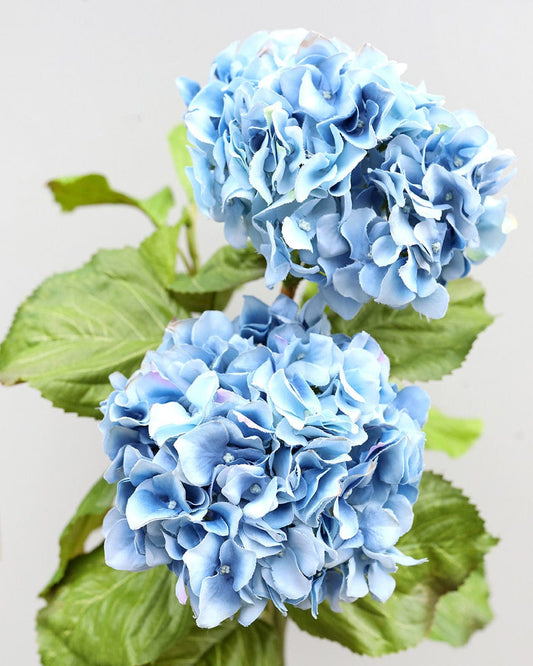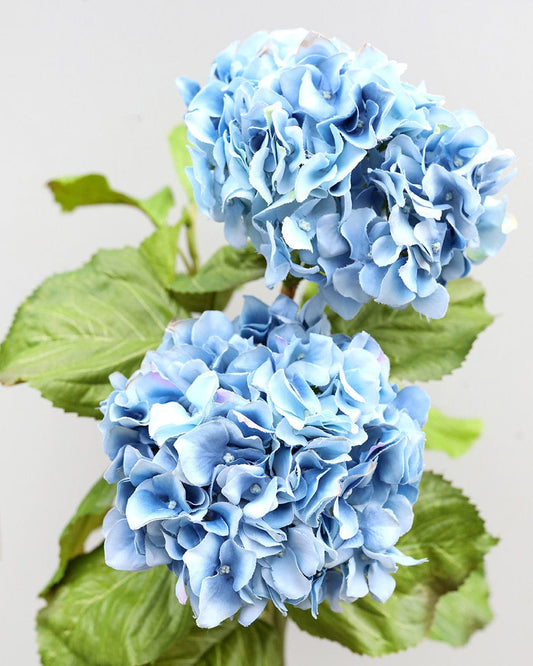Hydrangea Arrangements 101: Mix Real Touch Flowers with Artificial for Stunning Results

You know, there's something absolutely magical about the moment when you're arranging flowers and suddenly realize—wait, which ones are real touch and which are silk?
Through my work with Prestige Botanicals, I've discovered that the most breathtaking hydrangea arrangements happen when you stop thinking about categories and start thinking about texture harmony. Last month I was creating a centerpiece for a museum gala, and I caught myself second-guessing whether those gorgeous blooms were dusty rose or more of a mauve pink—honestly, color terminology can drive you a bit mad sometimes.
The secret isn't choosing between artificial hydrangeas and real touch varieties—it's understanding how to blend them so seamlessly that even experienced florists do a double-take. After 18 years of botanical consulting, I've learned that the most stunning arrangements tell a story through contrasting textures.
Key Takeaways
- Real touch hydrangeas provide velvety texture while silk varieties offer structural stability
- Layer different bloom densities to create natural-looking depth and movement
- Use the 60-40 rule: 60% real touch for focal impact, 40% silk for volume
- Strategic foliage placement bridges texture differences between flower types
- Color temperature matching matters more than exact shade coordination
Understanding Real Touch vs. Silk Hydrangea Characteristics
The foundation of any successful mixed arrangement lies in understanding what each material brings to the table. Real touch hydrangeas offer that incredible tactile experience—when you brush against the petals, they respond with the same gentle give as fresh blooms. I remember the first time I worked with these; I was absolutely stunned by how they captured that papery delicacy of actual hydrangea petals.
Silk hydrangeas provide the structural backbone your arrangements desperately need. They hold their shape beautifully, maintain consistent color saturation, and—here's something I learned during a particularly humid wedding season—they don't absorb moisture from the air like real touch varieties sometimes can.
What fascinates me most is how these two technologies complement each other's weaknesses. Real touch flowers can sometimes feel a bit too uniform, while silk varieties occasionally lack that organic irregularity that makes flowers feel alive. When you combine them thoughtfully, you get the best of both worlds.


Real Touch Blue Hydrangea 18"
Enchanting blue and purple tones with soft, velvety texture that feels remarkably lifelike
This particular real touch hydrangea perfectly demonstrates texture authenticity. Notice how the petals have that slightly irregular edge that makes them feel genuinely organic. The subtle color variations within each bloom—those hints of purple dancing through the blue—that's exactly the kind of natural imperfection that makes mixed arrangements sing.
The Science of Visual Balance in Mixed Arrangements
Here's where my botanical background really comes into play—there's actual science behind why certain combinations work while others fall flat. It all comes down to what I call "petal mathematics." The human eye naturally seeks patterns and rhythms, and when you're mixing textures, you need to create intentional chaos rather than accidental messiness.
I typically work with a 60-40 ratio as my starting point: 60% real touch for that immediate tactile appeal, 40% silk for structural support. But honestly, I've broken this rule countless times when the specific blooms demanded it. For those working with limited budgets or stem counts, our guide to creating stunning hydrangea centerpieces with minimal stems demonstrates how strategic placement can achieve professional results without requiring dozens of blooms.
The key is understanding visual weight. Real touch flowers often appear slightly heavier to the eye because of their texture depth, so you need fewer of them to create balance. I learned this during a corporate installation where I initially used equal amounts—the arrangement felt top-heavy and exhausting to look at.
 Pro Tip: Kyoto Master
Pro Tip: Kyoto Master


Cream White Cone Hydrangea 35.5"
Elegant cone-shaped blooms in soft cream tones, perfect for creating sophisticated structural elements
This cream cone hydrangea exemplifies exactly what I mean about structural support. See how the cone shape naturally draws the eye upward? When I use these as anchor points in mixed arrangements, they create visual stability that allows the softer real touch varieties to flow around them naturally.
Strategic Placement Techniques for Seamless Integration
The magic happens in the placement, not just the selection. I've developed what I call the "conversation method"—imagine your flowers are having a dialogue with each other. The real touch hydrangeas are the emotional speakers, full of nuance and feeling, while the silk varieties are the steady, reliable voices that keep the conversation grounded.
Start with your silk hydrangeas as foundation pieces. Place them at strategic points—typically in a triangular pattern if you're working with a traditional arrangement. These become your visual anchors. Then, let the real touch varieties dance between them, creating movement and emotional depth.
One technique I'm particularly fond of involves clustering real touch blooms in odd numbers (groups of three or five work beautifully) while using silk varieties to create connecting bridges between these emotional focal points. It's like creating a garden path that leads the eye naturally through your composition.
I also pay careful attention to silk hydrangeas positioning relative to light sources. Real touch flowers often have more complex surface textures that catch light differently than silk varieties, so you want to position them where they can show off that dimensional quality.
Professional Finishing Touches and Enhancement Strategies
Here's where years of museum work have taught me some insider secrets that most people never consider. The difference between a good arrangement and a truly professional one often lies in the details that happen after you think you're finished.
Foliage integration is absolutely critical when mixing textures. I always incorporate transitional elements—maybe some hydrangea artificial leaves or complementary greenery that helps bridge the textural gap between real touch and silk blooms.


Hydrangea Leaf Faux Foliage 20"
Realistic hydrangea foliage that adds authentic depth and texture to mixed arrangements
These leaves are absolutely essential for creating that seamless integration I'm always talking about. They provide the perfect textural bridge between different flower types, and their natural variations help mask any slight differences in manufacturing styles.
Color temperature adjustment is another professional technique. Even if you're working with similar colors, real touch and silk flowers can have slightly different undertones. Understanding these subtleties becomes particularly important when transitioning your hydrangea arrangements through different seasons, where warm versus cool tones can dramatically shift a room's ambiance. I often use a light misting with diluted floral spray to subtly adjust color temperatures and create better harmony.
 Pro Tip: The "Squint Test"
Pro Tip: The "Squint Test"
The final touch involves what I call "intentional imperfection." Real gardens aren't perfectly symmetrical, so I always introduce small asymmetries—maybe a single bloom turned at an unexpected angle, or a leaf that breaks the pattern slightly. It's these tiny rebellions against perfection that make arrangements feel truly alive.


White Double Hydrangea 36"
Luxurious double-bloom hydrangeas offering exceptional fullness and elegant white tones
This double hydrangea represents the kind of statement piece that can anchor an entire mixed arrangement. Its fuller bloom structure provides dramatic impact while maintaining the soft, romantic quality that makes hydrangeas so beloved.
Creating Your Signature Mixed Arrangement Style
What absolutely thrills me about this approach is how it opens up creative possibilities that neither real touch nor silk flowers can achieve alone. You're not just arranging flowers—you're orchestrating a sensory experience that engages both sight and touch in ways that feel completely natural.
I've seen clients become genuinely emotional when they realize they can't distinguish between the different flower types in a well-executed mixed arrangement. That moment of discovery—that little gasp of "Wait, which ones are which?"—that's when you know you've succeeded in creating something truly special.
The beauty of mastering mixed arrangements lies in developing your own signature approach. Maybe you become known for dramatic color transitions, or perhaps your specialty becomes incredibly naturalistic compositions that fool even experienced gardeners. Through my consulting work with Prestige Botanicals, I've learned that the most successful arrangers develop a recognizable style that feels uniquely their own.
Remember, the goal isn't to create arrangements where nobody can tell the difference between real touch and silk—it's to create arrangements where the difference doesn't matter because the overall effect is so compelling. When someone walks into a room and immediately gravitates toward your creation, asking "How did you make it look so alive?"—that's when you know you've mastered the art of fake hydrangeas integration.
Frequently Asked Questions
Can you really not tell the difference between real touch and silk hydrangeas in a mixed arrangement?
When done correctly, absolutely! The key is understanding each material's strengths and using them strategically. Real touch provides that authentic tactile experience, while silk offers structural support. I've had museum curators examine my mixed arrangements for several minutes before identifying which flowers were which technology.
What's the best ratio of real touch to silk hydrangeas for beginners?
I recommend starting with a 60-40 ratio—60% real touch for emotional impact, 40% silk for stability. This gives you enough tactile variety to create interest while maintaining structural integrity. As you gain confidence, you can experiment with different ratios based on your specific design goals.
Do mixed arrangements require special care or maintenance?
The beauty of mixed arrangements is that they're virtually maintenance-free! Just dust occasionally with a soft brush and keep them away from direct sunlight to prevent any color fading. Real touch flowers are slightly more sensitive to humidity than silk, but in normal home conditions, this isn't a concern.
How do you handle color matching when the textures are different?
Focus on color temperature rather than exact shade matching. Real touch and silk flowers may have slightly different undertones even in the same color family. I often use transitional elements like foliage or complementary blooms to bridge any subtle color differences. The eye is remarkably forgiving when the overall composition feels harmonious.
Ready to create your own stunning mixed arrangements? Explore our complete premium hydrangea collection to find the perfect combination of real touch and silk varieties for your design vision.










